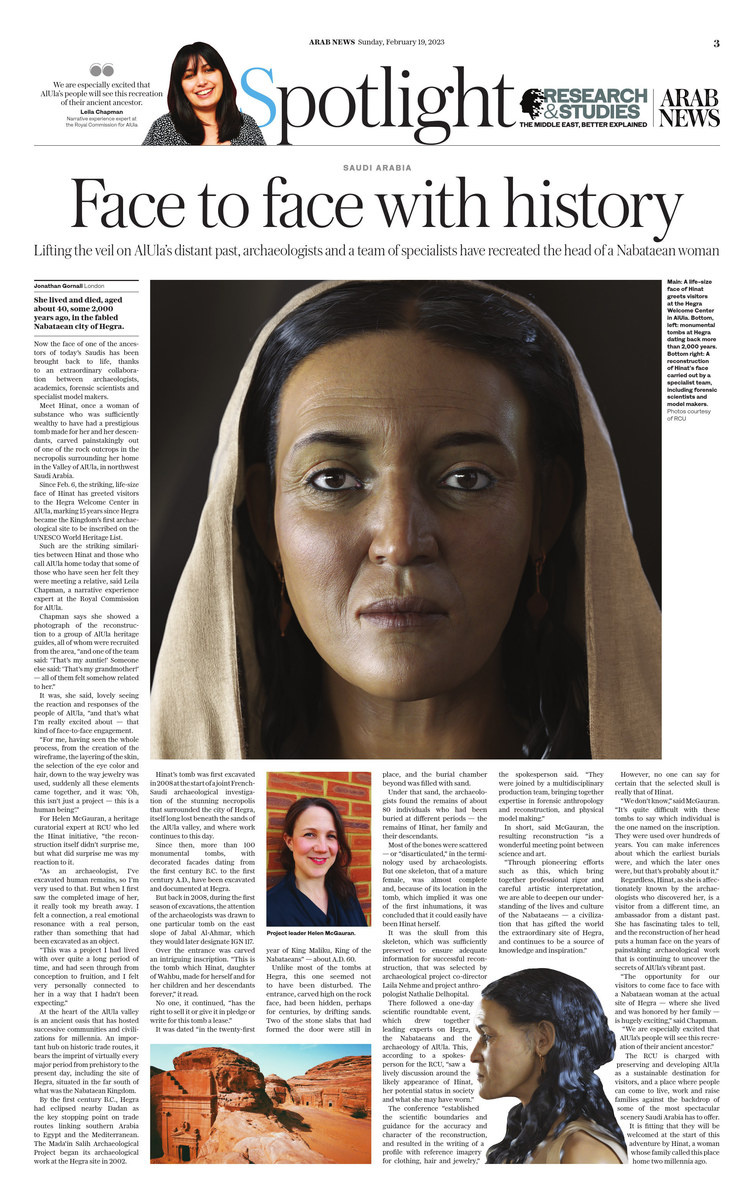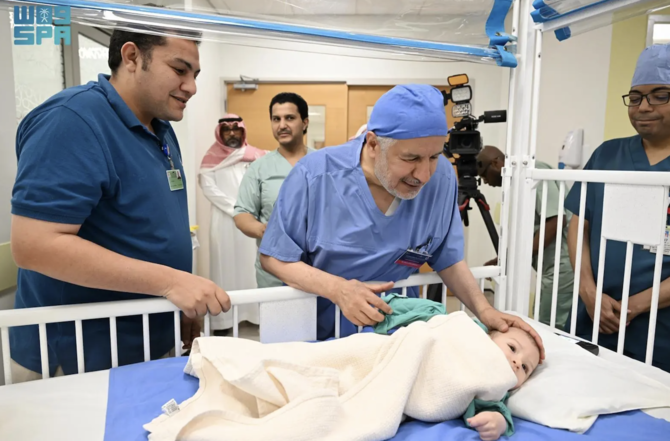LONDON: She lived and died aged about 40 some 2,000 years ago, in the fabled Nabataean city of Hegra.
Now the face of one of the ancestors of today’s Saudis has been brought back to life, thanks to an extraordinary collaboration between archaeologists, academics, forensic scientists and specialist model makers.
Meet Hinat, once a woman of substance who was sufficiently wealthy to have had a prestigious tomb made for her and her descendants, carved painstakingly out of one of the rock outcrops in the necropolis surrounding her home in the Valley of AlUla, in northwest Saudi Arabia.
Since Feb. 6, the striking, life-size face of Hinat has greeted visitors to the Hegra Welcome Center in AlUla, marking 15 years since Hegra became the Kingdom’s first archaeological site to be inscribed on the UNESCO World Heritage List.

Since Feb. 6, the life-size face of Hinat has greeted visitors to the Hegra Welcome Center in AlUla. (Photo courtesy of RCU)
Such are the striking similarities between Hinat and those who call AlUla home today that some of those who have seen her felt they were meeting a relative, said Leila Chapman, a narrative experience expert at the Royal Commission for AlUla.
Chapman says she showed a photograph of the reconstruction to a group of AlUla heritage guides, all of whom were recruited from the area, “and one of the team said: ‘That’s my auntie!’ Someone else said: ‘That’s my grandmother!’ — all of them felt somehow related to her.”
It was, she said, lovely seeing the reaction and responses of the people of AlUla, “and that’s what I’m really excited about — that kind of face-to-face engagement.
“For me, having seen the whole process, from the creation of the wireframe, the layering of the skin, the selection of the eye color and hair, down to the way jewelry was used, suddenly all these elements came together, and it was: ‘Oh, this isn’t just a project — this is a human being’.”
For Dr. Helen McGauran, a heritage curatorial expert at RCU, who led the Hinat initiative, “the reconstruction itself didn’t surprise me, but what did surprise me was my reaction to it.
“As an archaeologist, I’ve excavated human remains, so I’m very used to that. But when I first saw the completed image of her, it really took my breath away. I felt a connection, a real emotional resonance with a real person, rather than something that had been excavated as an object.
“This was a project I had lived with over quite a long period of time, and had seen through from conception to fruition, and I felt very personally connected to her in a way that I hadn’t been expecting.”
At the heart of the AlUla valley is an ancient oasis that has hosted successive communities and civilizations for millennia. An important hub on historic trade routes, it bears the imprint of virtually every major period from prehistory to the present day, including the site of Hegra, situated in the far south of what was the Nabataean Kingdom.
By the first century B.C., Hegra had eclipsed nearby Dadan as the key stopping point on trade routes linking southern Arabia to Egypt and the Mediterranean. The Mada’in Salih Archaeological Project began its archaeological work at the Hegra site in 2002.
Hinat’s tomb was first excavated in 2008 at the start of a joint French-Saudi archaeological investigation of the stunning necropolis that surrounded the city of Hegra, itself long lost beneath the sands of the AlUla valley, and where work continues to this day.

Monumental tombs at Hegra dating back more than 2,000 years. (Photo courtesy of RCU)
Since then, more than 100 monumental tombs, with decorated facades dating from the first century B.C. to the first century A.D., have been excavated and documented at Hegra.
But back in 2008, during the first season of excavations, the attention of the archaeologists was drawn to one particular tomb on the east slope of Jabal Al-Ahmar, which they would later designate IGN 117.
Over the entrance was carved an intriguing inscription. “This is the tomb which Hinat, daughter of Wahbu, made for herself and for her children and her descendants forever,” it read.
No one, it continued, “has the right to sell it or give it in pledge or write for this tomb a lease.”
It was dated “in the twenty-first year of King Maliku, King of the Nabataeans” — approximately 60 A.D.
Unlike most of the tombs at Hegra, this one seemed not to have been disturbed. The entrance, carved high up on the rock face, had been hidden, perhaps for centuries, by drifting sands. Two of the stone slabs that had formed the door were still in place, and the burial chamber beyond was filled with sand.
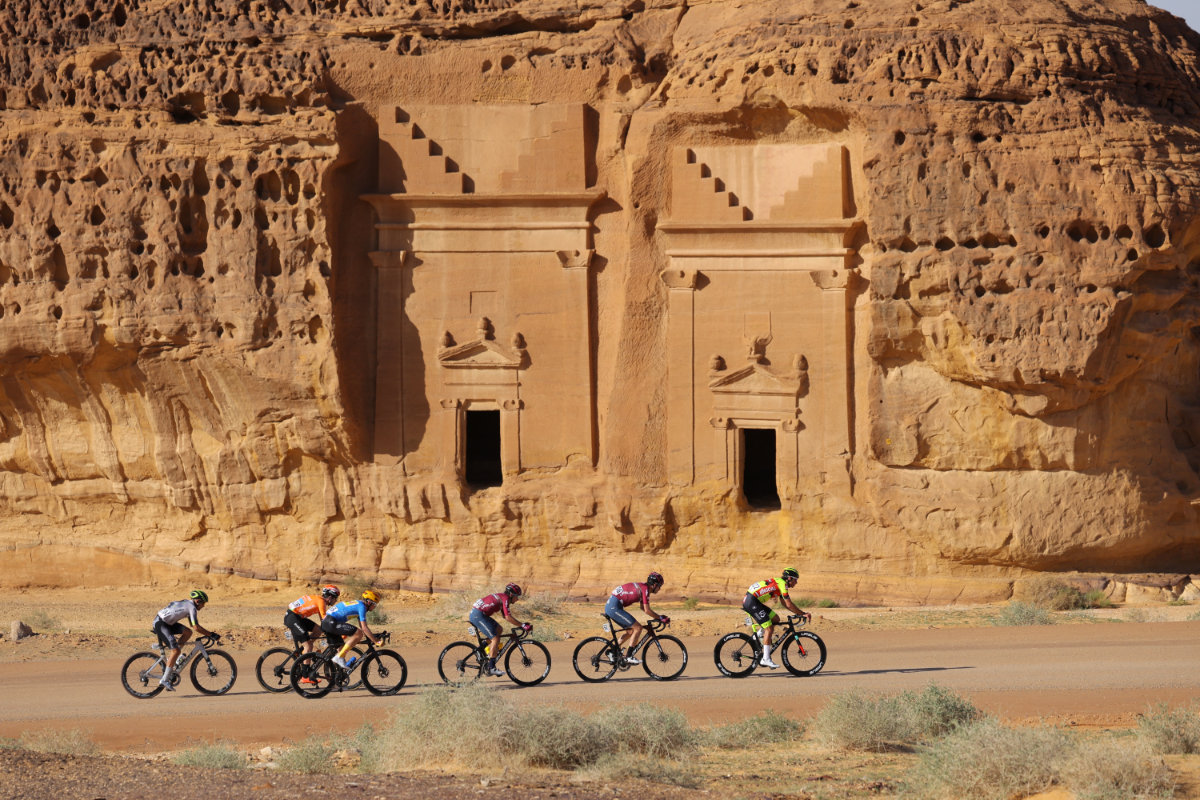
Cyclists ride past ancient Nabataean tombs in Hegra on February 3, 2023, during the fifth stage of 2023 Saudi Tour, from Al-Ula Old Town to Maraya. (Thomas Samson / AFP)
Under that sand, over several seasons of careful excavation, the archaeologists found the remains of about 80 individuals who had been buried at different periods — the remains of Hinat, her family and their descendants.
Most of the bones were scattered — or “disarticulated,” in the terminology used by archaeologists. But one skeleton, that of a mature female, was almost complete and, because of its location in the tomb, which implied it was one of the first inhumations, it was concluded that it could easily have been Hinat herself.
It was the skull from this skeleton, which was sufficiently preserved to ensure adequate information for successful reconstruction, that was selected by archaeological project co-director Laila Nehme and project anthropologist Nathalie Delhopital.
There followed a one-day scientific roundtable event, which drew together leading experts on Hegra, the Nabataeans and the archaeology of AlUla. This, according to a spokesperson for the RCU, “saw a lively discussion around the likely appearance of Hinat, her potential status in society and what she may have worn.”
The conference “established the scientific boundaries and guidance for the accuracy and character of the reconstruction, and resulted in the writing of a profile with reference imagery for clothing, hair and jewelry,” the spokesperson said.
“They were joined by a multidisciplinary production team, bringing together expertise in forensic anthropology and reconstruction, and physical model making.”
In short, said McGauran, the resulting reconstruction “is a wonderful meeting point between science and art.
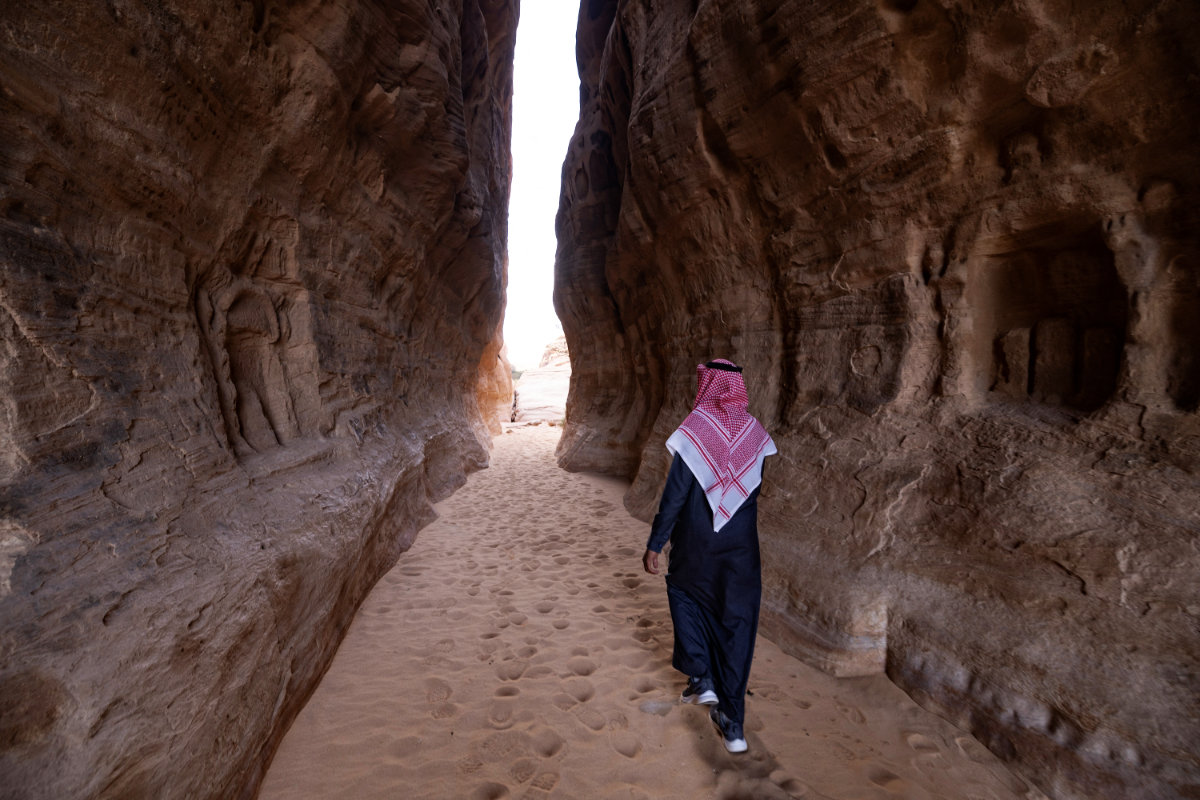
A Saudi man walks amid ancient Nabataean carved tombs at the archaeological site of al-Hijr (Hegra), near the northwestern Saudi city of al-Ula. (AFP)
“Through pioneering efforts such as this, which bring together professional rigor and careful artistic interpretation, we are able to deepen our understanding of the lives and culture of the Nabataeans — a civilization that has gifted the world the extraordinary site of Hegra, and continues to be a source of knowledge and inspiration.”
No one, however, can say for certain that the selected skull is really that of Hinat.
“We don’t know,” said McGauran. “It’s quite difficult with these tombs to say which individual is the one named on the inscription. They were used over hundreds of years. You can make inferences about which the earliest burials were, and which the later ones were, but that’s probably about it.”
Regardless, Hinat, as she is affectionately known by the archaeologists who discovered her, is a visitor from a different time, an ambassador from a distant past. She has fascinating tales to tell, and the reconstruction of her head puts a human face on the years of painstaking archaeological work that is continuing to uncover the secrets of AlUla’s vibrant past.
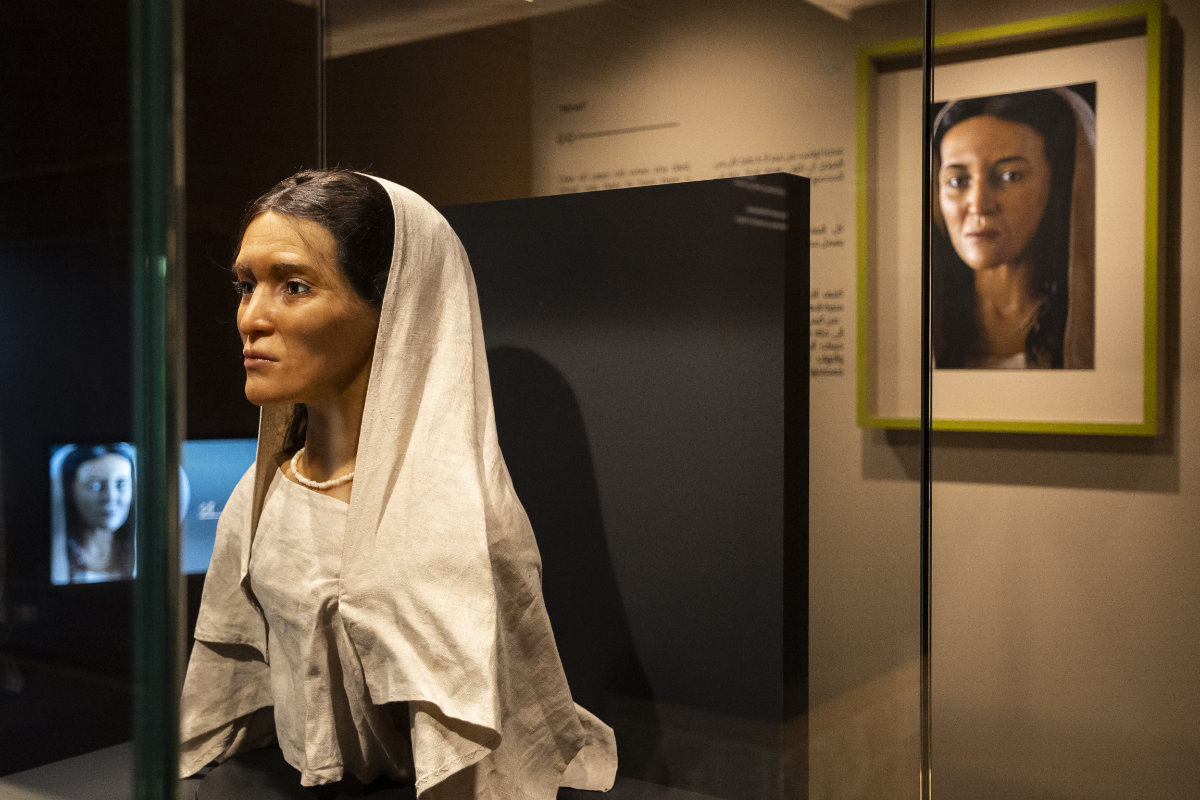
Since Feb. 6, 2023, the life-size face of Hinat has greeted visitors to the Hegra Welcome Center in AlUla. (Photo courtesy of RCU)
“The opportunity for our visitors to come face to face with a Nabataean woman at the actual site of Hegra — where she lived and was honored by her family — is hugely exciting,” said Chapman.
“We are especially excited that AlUla’s people will see this recreation of their ancient ancestor.”
The RCU is charged with preserving and developing AlUla, a region of outstanding natural and cultural significance, as a sustainable destination for visitors, and a place where people can come to live, work and raise families against the backdrop of some of the most spectacular scenery Saudi Arabia has to offer.
It is fitting that they will be welcomed at the start of this adventure by Hinat, a woman whose family called this place home two millennia ago.
